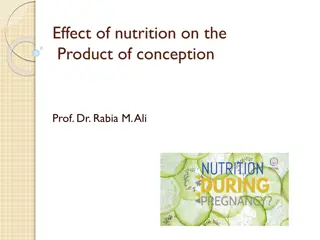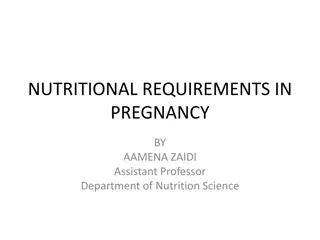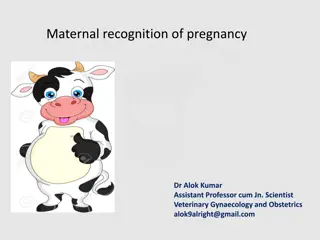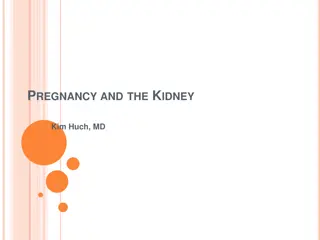
Physiological Adaptations to Pregnancy and Delivery by Dr. Esraa AL-Maini
Physiological adaptations during pregnancy include changes in blood volume, cardiac output, and vascular resistance, impacting maternal and fetal health. Understanding these adaptations is crucial for effective maternal care.
Download Presentation

Please find below an Image/Link to download the presentation.
The content on the website is provided AS IS for your information and personal use only. It may not be sold, licensed, or shared on other websites without obtaining consent from the author. If you encounter any issues during the download, it is possible that the publisher has removed the file from their server.
You are allowed to download the files provided on this website for personal or commercial use, subject to the condition that they are used lawfully. All files are the property of their respective owners.
The content on the website is provided AS IS for your information and personal use only. It may not be sold, licensed, or shared on other websites without obtaining consent from the author.
E N D
Presentation Transcript
Physiological adaptations to pregnancy and delivery Professor Dr.Esraa AL-Maini
-Blood volume starts to rise by the fifth week after Conception secondary to progesterone induced relaxation of smooth muscle that increases the capacitance of the venous bed. - Plasma volume increases and red cell mass rises but to a lesser degree, thus explaining the physiological anemia of pregnancy. Relaxation of smooth muscle on the arterial side results in a profound fall in systemic vascular resistance and together with the increase in blood volume determines the early increase in cardiac output.
Blood pressure falls slightly, but by term has usually returned to the pre pregnancy value. -The increased cardiac output is achieved by an increase in stroke volume and a lesser increase in resting heart rate of 10 20 bpm. By the end of the second trimester the blood volume and stroke volume have risen by between 30 and 50%. This increase correlates with the size and weight of the products of conception and is therefore considerably greater in multiple pregnancies as is the risk of heart failure in women with concomitant heart disease
Although there is no increase in pulmonary capillary wedge pressure, serum colloid onconic pressure is reduced. The gradient between them is reduced by 28%, making pregnant women particularly susceptible to pulmonary oedema.
Pulmonary edema will be precipitated if there is an - increase in cardiac preload (such as infusion of fluids) -increased pulmonary capillary permeability (such as in pre eclampsia), or both.
In late pregnancy in the supine position, pressure of the gravid uterus on the inferior vena cava (IVC) causes a reduction in venous return to the heart and a consequent fall in stroke volume and cardiac output. Turning from the lateral to the supine position may result in a 25% reduction in cardiac output. Reduced cardiac output is associated with reduction in uterine blood flow and therefore placental perfusion; this can compromise the fetus.
Pregnant women should therefore be nursed in the left or right lateral position wherever possible.
LABOUR: Labour is associated with further increases in cardiac output 15% in the first stage 50% in the second stage Uterine contractions lead to autotransfusion of 300 500 mL of blood back into the circulation The sympathetic response to pain and anxiety further elevate heart rate and blood pressure.
Cardiac output is increased more during contractions but also between contractions. The rise in stroke volume with each contraction is attenuated by Good pain relief Epidural analgesia Supine position.
In the third stage up to 1 L of blood may be returned to the circulation due to the relief of IVC obstruction and contraction of the uterus. The intrathoracic and cardiac blood volumes rise, and cardiac output increases by 60 80% followed by a rapid decline to pre labour values within about 1 hour of delivery. Transfer of fluid from the extravascular space increases venous return and stroke volume further. Those women with cardiovascular compromise are therefore most at risk of pulmonary oedema during the third stage of labour and the immediate postpartum period.
All the changes revert quite rapidly during the first week and more slowly over the following 6 weeks, but even at 1 year significant changes still persist and are enhanced by a subsequent pregnancy .
Normal findings on examination of the cardiovascular system in pregnancy These may include a loud first heart sound with splitting of the second heart sound and a physiological third heart sound at the apex. exaggerated A systolic ejection murmur at the left sternal edge is heard in nearly all women and may be remarkably loud and be audible all over the precordium It varies with posture and if unaccompanied by any other abnormality reflects the increased stroke output .
However, diastolic murmurs are virtually always pathological. Venous hums and mammary souffles may be heard. and in addition ectopic beats are very common in pregnancy. Ankle swelling is common in the normal pregnant woman but if accompanied by hypertension consider pre eclampsia.
Cardiac investigations in pregnancy The ECG axis shifts slightly to the left (superiorly) in late pregnancy due to a more horizontal position of the heart. -Small Q waves and T wave inversion in the inferior leads are not uncommon. Atrial and ventricular ectopics are both common. Troponin is not affected by pregnancy and remains a valid test for myocardial ischaemia.
The amount of radiation received by the fetus during a maternal chest X ray (CXR) is negligible and CXR should never be withheld if clinically indicated in pregnancy. Transthoracic echocardiography is the investigation of choice for excluding, confirming or monitoring structural heart disease in pregnancy.
Transoesophageal echocardiography is also safe with the usual precautions to avoid aspiration Magnetic resonance imaging (MRI) Chest computed tomography (CT) are safe in pregnancy. Routine investigation with electrophysiological studies are normally postponed until after pregnancy but angiography should not be withheld in, for example, acute coronary syndromes.
Ventricular Function in Pregnancy Ventricular volumes increase to accommodate hypervolemia. This is reflected by increasing endsystolic as well as end-diastolic dimensions. there is no change in septal thickness or in ejection fraction. This is because these changes are accompanied by ventricular remodeling which is characterized by eccentric expansion of left-ventricular mass that averages 30 to 35 percent near term. All of these adaptations return to prepregnancy values within a few months postpartum.
for clinical purposes, ventricular function during pregnancy is normal so that cardiac function during pregnancy is eudynamic. Despite these findings, it remains controversial whether myocardial function per se is normal, enhanced, or depressed.
Echocardiographic functional indices Myocardial performance is measured by preload, afterload, contractility, and heart rate. they can only be measured indirectly because these depend on ventricular geometry, they can only be measured indirectly In non pregnant subjects with a normal heart who sustain a high-output state, the left ventricle undergoes longitudinal remodeling, and echocardiographic functional indices of its deformation provide normal values.
In pregnancy, there instead appears to be spherical remodeling, and these calculated indices that measure longitudinal deformation are depressed. Thus, these normal indices are likely inaccurate when used to assess function in pregnant women because they do not take into account the spherical eccentric hypertrophy characteristic of normal pregnancy.
Thank Thank you you neonatal complications of diabetes mellitus






















